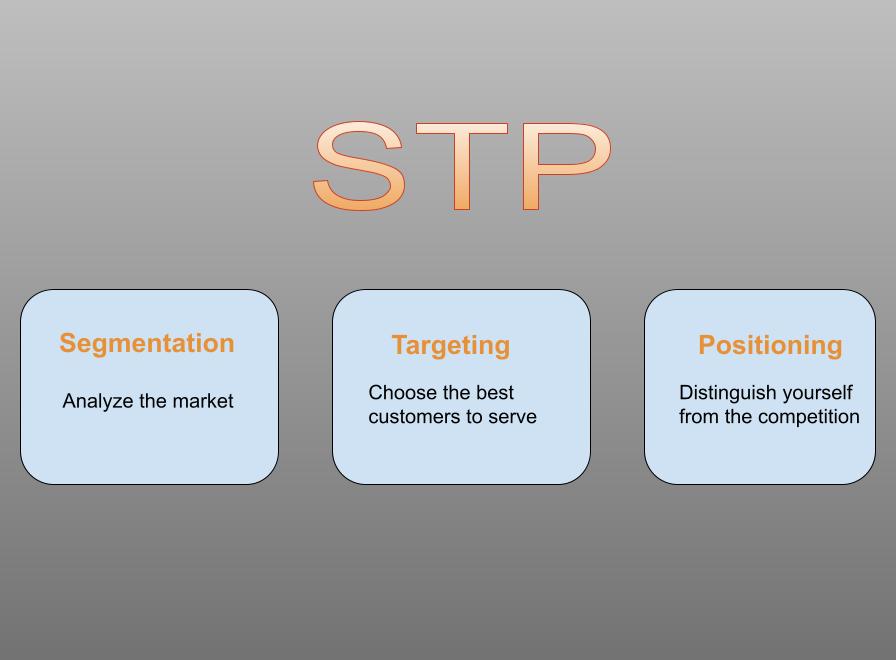
What is Segmentation, Targeting and Positioning in Marketing
Have you ever wondered why certain businesses succeed at marketing while others struggle? Marketing is difficult; you often must experiment with several strategies before settling on a winning strategy. The solution is a well-planned and implemented STP marketing strategy. STP stands for Segmentation, Targeting, and Positioning. It is the process of researching, evaluating, and recognizing the needs of your market, developing a service or product to meet those needs, and then determining the best way to reach those potential customers.
Every company aims to identify its ideal customer and develop communication systems that attract them. Creating an STP model in marketing can be challenging, but it's a crucial step for any business looking to grow. If properly implemented, the STP marketing strategy improves customer personalization and yields excellent returns on investment.
The segmentation, targeting, and positioning process enables marketers to divide their market opportunities into customers with similar needs and preferences. From there, they can focus on particular targets by customizing their product offerings and communication messages to best serve those customers and increase market share.
How Can the STP Model in Marketing Help Your Business?
Businesses can use a variety of marketing strategies to reach their target audience. The STP marketing strategy involves segmenting the market and targeting specific demographics. To increase sales, you should use an STP marketing model. The STP approach will help you identify your intended targets, understand their requirements, and develop services or products that appeal to them. As a result, it will significantly enhance your chances of success.

In today's environment, businesses must find ways to maintain their customer relationships. Therefore, the prime focus of the STP marketing strategy is building long-term relationships with customers by delivering superior products and services. Sustainability implies that you can keep your customers and market segments satisfied for a long time.
The STEP formula is the most straightforward way to remember the STP model in marketing.
Segmentation + Targeting = Positioning
A thorough look at this formula illustrates that the product positioning for each target segment differs. It is the core of the segmentation, targeting, and positioning marketing model.
What Segmentation, Targeting, and Positioning in Marketing Mean
Regarding marketing, terms like segmenting, targeting, and positioning have various meanings. For example, marketers start the process by breaking markets into multiple groups of customers who share similar characteristics, such as age and financial scale. The terminology associated with this is "market segmentation." Marketers utilize segmentation to find customers with similar requirements and preferences so that they can customize their services or products for them.
After segmenting the market, organizations must choose which segments to target with their products and services. It is called “targeting.” To customize marketing messages to each subset of customers, each segment must be analyzed for its potential profitability and compatibility with the company's position in the market.
The third phase of the STP marketing strategy is called "positioning." Marketers aim to position their offerings against competitors by making decisions about their features, prices, promotions, and other mix components. The company has now developed a position in the market that would set them apart from rivals and entice target customers. Marketers use positioning to express how they want customers to perceive and remember their company compared to the competition.
STP marketing strategy provides companies with information about customer patterns, which is essential when launching new products or adapting advertising campaigns at different product life cycle stages. With accurate segmentation, targeting, and positioning strategies, businesses can craft appropriate messages using valid methodologies for specific groups identified by the STP model, who have the best chance of becoming loyal customers in the long run.
Segmentation, Targeting, and Positioning Example
The STP model in marketing is a fundamental business strategy. Let's take a look at a segmentation, targeting, and positioning example to better understand how this process works:
Consider the consumer electronics industry as an example. This market is becoming saturated as gadget manufacturers compete for market share. So again, we'll use Apple Inc. as our segmentation, targeting, and positioning example.
In terms of segmentation, Apple does not focus on one particular group but instead divides its markets into five distinct groups: young adults (ages 18-25), mature adults (ages 26- 40), business users (generally using Mac laptops), students (mainly using iPads), and older consumers (over the 40s).
For its targeting strategy, Apple focuses significantly on the younger generations, who are seen as setting trends in the tech industry. They also target professionals, who often prefer the functionality of more essential products like their MacBook Pro line of laptops. They also try to reach business users who require powerful equipment, older customers seeking simple but reliable products, and younger adults looking for the newest, most cutting-edge technology.
Apple's positioning is based on design innovation and high-quality hardware and software features. They place a high value on innovative product designs, although most competitors may offer similar specifications at lower prices. In addition, they differentiate themselves from others by emphasizing their commitment to innovation through design, quality, and reliability—something that many other competing brands do not offer or attempt to emulate in any way.
Importance of STP Model in Marketing
STP marketing helps understand a target market and audience, allowing brands to significantly increase their sales. In addition, it assists businesses in placing their services or products in targeted markets. All of this contributes to avoiding unnecessary marketing and advertising expenditures.
We'll outline the key benefits of STP marketing over a conventional marketing strategy if you're not convinced that it will transform your business.
- Increased engagement: Your audience finds you trustworthy and is much more likely to connect with you and convert when you are connecting to specific audience groups with personalized messages.
- Reduced marketing expenses: You are no longer wasting money on ineffective channels and market segments by focusing solely on market segments with high ROI potential.
- Better product: Since you know exactly who you are selling your product to, you can make improvements based on their feedback, which supports targeted product innovation.
Using segmentation, you can group potential customers with similar needs into segments. As a result, it makes it easier to attract the right customer. This way, your company will avoid the risk of determining how, when, where, and to whom you will market a product. As a result, the STP approach contributes to an improvement in marketing performance, an increase in customer retention, and a decrease in customer acquisition costs.
How to Implement the STP Marketing Strategy
Creating market segments is the initial step. We now live in the era of digital, targeted marketing; the days of generic marketing are long gone. Your company must use market segmentation to place each client into one of these categories. As we explained, this may be based on gender, country, or other related characteristics. It enables your business to change its marketing or sales strategy to meet the requirements of each group.
There are many methods for segmenting your target markets. One of them is size, while another is profitability. When segmenting, consider which of your segments is likely to spend money on a service or product.
Another essential factor when implementing the STP marketing model is reachability. Therefore, you must evaluate a company's marketing efforts in terms of the ease with which you can reach each segment. A further important factor is customer acquisition costs; the higher they are, the less profit can be obtained from that group of customers.
Positioning your service or product is the final phase of the STP marketing model. A company must know how to set its service to reach the customer segments.
Consider the following points:
- Why should consumers choose your product over that of your competitors?
- What is your unique selling point?
Then, after matching it with your customers' needs, you can formulate a value proposition that makes it simple for a brand to emphasize the importance of its service or product compared to the competition. Also, remember that the STP marketing strategy for the B2B market differs from that for the B2B market.
Conclusion
The STP model is an achievable marketing strategy that supports businesses in identifying target markets where they can add value, customize their brand message, and generate substantial profits. Marketers frequently utilize the segmentation, targeting, and positioning marketing model since it guides you through steps that enable you to recognize the brand, know the target market, and discover other factors necessary for developing effective marketing strategies.





